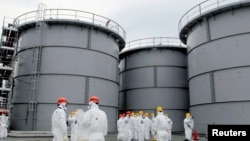Japanese nuclear officials say the radiation level of a tank holding highly contaminated water at Japan's crippled Fukushima nuclear plant has jumped in just one week to a potentially dangerous level.
Tokyo Electric Power Company, or Tepco, said the reading of 1,800 millisieverts at the tank Saturday is enough to kill an exposed person in four hours. On August 22, the same tank measured 100 millisieverts per hour - just a fraction of Saturday's reading.
Tepco also revealed that a pipe connecting two other tanks is leaking. However, the energy company said the water levels of the tanks had not changed. The French news agency says the leak has been patched with plastic tape.
Last month, a tank was found to have leaked 300 tons of highly toxic water.
The tanks at Fukushima are built with steel plates and are held together with bolts.
Reuters news agency says Tepco is seeking foreign decommissioning experts for advice on how to deal with the highly radioactive water leaking from the site.
The Fukushima Daiichi power plant, north of Tokyo, was devastated by a tsunami in March 2011 that resulted in fuel-rod meltdowns at three reactors, radioactive contamination of the air, sea and food, and the evacuation of more than 100,000 people.
Tokyo Electric Power Company, or Tepco, said the reading of 1,800 millisieverts at the tank Saturday is enough to kill an exposed person in four hours. On August 22, the same tank measured 100 millisieverts per hour - just a fraction of Saturday's reading.
Tepco also revealed that a pipe connecting two other tanks is leaking. However, the energy company said the water levels of the tanks had not changed. The French news agency says the leak has been patched with plastic tape.
Last month, a tank was found to have leaked 300 tons of highly toxic water.
The tanks at Fukushima are built with steel plates and are held together with bolts.
Reuters news agency says Tepco is seeking foreign decommissioning experts for advice on how to deal with the highly radioactive water leaking from the site.
The Fukushima Daiichi power plant, north of Tokyo, was devastated by a tsunami in March 2011 that resulted in fuel-rod meltdowns at three reactors, radioactive contamination of the air, sea and food, and the evacuation of more than 100,000 people.







